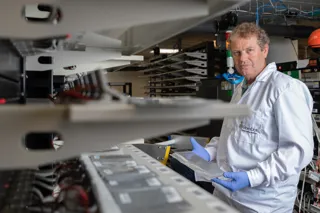This feature originally appeared in the July 2022 edition of Fleet News. Click here to read the article in the digital issue of the magazine.

We’ve all had first-hand experience of battery degradation – fresh from its box, the battery in a new smartphone seems like it will last forever.
Over time, however, the phone needs to be charged more often as its battery capacity reduces. This is also true of batteries used in electric vehicles (EVs), which share a similar chemistry.
In the case of an EV, though, the reduced capacity means the vehicle will suffer a decrease in range, while there are also concerns battery health will adversely affect an EV’s residual value (RV).
However, this is not an issue many consumers currently worry about, says Chris Plumb, senior valuations editor at pricing guide Cap HPI.
He adds: “In the future, we believe that battery degradation data for used electric vehicles is likely to be just as important as mileage is for ICE (internal combustion engine) vehicles as the used buyer will want to know the state of health of the battery/vehicle they are purchasing.
“However, in today’s market, where nearly all new BEVs (battery electric vehicles) are supplied with an eight-year battery warranty, consumers appear to be less concerned.”
In this feature, we look at the five big questions fleet decision-makers should be asking about battery degradation.
What is battery degradation and why does it happen?
Degradation is the loss of capacity and power within a battery and occurs due to an array of chemical processes within its cells.
It happens either through the ageing of a battery over time when it is not in use – called calendar ageing – or the charging and discharging of it – known as cycling ageing.
Both are unavoidable.
Calendar ageing is mostly affected by its state of charge and the length of time the battery is left, as well as the temperature the vehicle is stored in. Cycling ageing results from chemical processes when the battery is being used and is typically influenced by ambient temperature, number and type of charge cycles, and depth and rate of discharge.
The actual capacity of a battery during its life is referred to as its state of health (SoH) and this is calculated using a percentage compared with when it was new and at 100%.
Put simply, a battery with a range of 200 miles, when new, but now with a 90% SoH would have a range of 180 miles.
While for many users a slight drop in capacity may not make much difference, the more severe the reduction is, the more potential there is for the vehicle not to be able to do the duty it was acquired to do.
A battery is considered to be at its end of life in a vehicle when it falls to a 70% SoH. Most experts expect a battery to reach this after about 10 years, although there is the potential for it to last much longer.
After this point, batteries can either be used in second-life applications such as domestic or industrial energy storage, or recycled.
How quickly do EV batteries degrade?
There is no simple answer to this. The rate of degradation is affected by numerous factors, including age, ambient conditions and how a battery is charged and discharged.
Research by EV battery data, health and warranty specialists Altelium has found that a standard automotive cell could be at 80% SoH in its hard usage profile case after around four years, but it takes 15 years to get to the same state with easy usage.
“The really big thing is your use case,” says Alex Johns, business development manager at Altelium, who also chaired this year’s European Electric Vehicle Battery Summit.
“If you’re driving flat out, braking heavily, always rapid charging, you’re going to knacker your battery.
“If you run a battery hard, it might have a quarter of the life compared with if you run it sensibly. I know this because I used to run a taxi fleet at Gatwick Airport where we had five Tesla Model S’s.
“We did 100,000 miles a year on each for three years, so we ran each of them for 300,000 miles.
“At the end of that, because we deployed various rules around no more than 30% DC charging, the cars were in chill/eco mode so they couldn’t be run like a drag car and things like that. They were driven fairly gently.
“We had 82% state of health left, give or take very little, car to car, after 300,000 miles. That’s amazing.
“It’s not just a matter of a few tenths of a percent or a few percent between a hard-worked battery and a not-hard-worked one, it’s hundreds of percent. You could see 400% more life if you run it gently.”
Johns says as the average car in the UK is used for only one hour a day, in many instances the primary cause of battery degradation could be calendar ageing.
“That may only be 0.4% SoH a year, or something like that, but if you’re intending to keep your car for a decade, that obviously adds up to 4%,” he adds.

How will battery health affect residual values?
Cap HPI expects vehicle RVs will be impacted by the SoH of an EV’s battery, but the extent is not yet clear.
“In its simplest form you could have two identical vehicles with matching mileages, age and condition.
“However, one has a retained battery health of 90% and the other 70%,” says Plumb.
“In today’s market, they attract the same value, but the vehicle with less degradation should be worth more.
“At the moment, it’s too early to comment on the monetary impact of battery health on RVs. However, this is something we are actively monitoring and Cap HPI is in discussions with a number of parties who are interested in working with us.”
The British Vehicle Rental & Leasing Association (BVRLA) is also looking into this issue and is collaborating with other organisations, including the Office for Zero Emission Vehicles (OZEV).
“It is important that universally agreed standards are adopted across the market, giving everybody a quick, clear and consistent understanding of the status of a vehicle,” says Toby Poston, director of corporate affairs at BVRLA.
“A common approach to assessing battery status, provided via a battery health certificate, would help operators to manage their fleet effectively while also having more predictable vehicle values at both ends of the lifecycle.”
Poston says the BVRLA is also updating its industry-recognised Fair Wear & Tear standards, with a new car version due later this year.
“Keeping pace with – and anticipating – the changing vehicle parc, the new standard will contain more guidance relating to electric vehicles,” he adds.
The situation is complicated further, says Liam Mifsud, programme manager at battery analytics specialist Silver Power Systems, as although two batteries may have the same SoH, “one is going to last you another five years; the other six months”.
This is because the way the battery has been treated up to that point will also affect how it will degrade in the future.
If it has been constantly rapid charged, for example, it’s SoH will decrease faster in future than if the battery has only been charged slowly. This is why it is important fleets have access to data on the battery’s history, says Mifsud.
“If you have a record of how the battery has been treated, then, arguably, you have a better RV because you can show that battery is superior to one where you have no data available,” he adds.
“I could see a scenario developing in the years to come where people would prefer to buy a second-hand vehicle from a fleet which has a return-to-depot charging policy so the charging has been actively managed by the owner to conform to a certain criteria, as opposed to a fleet where the vehicles disappear every day and they get charged in random ways and random times.”
How can a fleet manager minimise battery degradation?
BEV batteries already have built-in management technologies to protect them from the worst extremes of degradation.
These include thermal management systems to ensure the battery is operating and taking on charge at optimum temperatures: this is why batteries are able to rapid charge up to 80% capacity before slowing for the remainder, as this prevents them from getting too hot.
Another way manufacturers protect the life of batteries is for them to maintain a residual capacity so they are never completely drained, as this can also damage a battery.
This is why vehicle makers sometimes quote both the overall size of the battery as well as a slightly smaller useable capacity.
However, there are also actions fleet decision-makers and drivers can take.
“One reason batteries degrade is heat,” says Johns. “Instead of charging at 4kW at home, for example, you could be charging at 100kW which is 25 times the speed and this is going to create heat.
“One recommendation is to charge as slowly as possible. That will be appreciated by the battery.”
Dependent on the use-case of the vehicle, this may not be possible as the driver may take the vehicle home at night and not have access to slower chargers, or if the vehicle is doing a lot of miles during the day then rapid charging is unavoidable.
“Some fleets are going to have business constraints that are going to conflict potentially with best practice for battery health,” says Pete Bishop, chief technology officer at Silver Power Systems.
Monitoring the health of batteries can be useful in these circumstances.
“You can balance that out by switching the vehicles to other drivers, changing the route they run on, to preserve an average state of health across your fleet, so, when you come to defleet, all the vehicles are in a similar condition,” he adds.
“You can now start to match the vehicle’s capability with the use it is going to be put to, potentially extending the life of that.”
However, getting hold of data may not be straightforward. Johns says manufacturers are “very touchy about allowing data out” although almost all modern EVs monitor battery health.
Silver Power Systems is one of the third-party companies which can collect this data, and does this by using a small IoT (internet of things) device located in the vehicle.
This transmits the data to cloud-based software and allows analysis of the battery, including current health and how it has been used and charged throughout its life.
Fleets should also avoid completely charging a battery or running it too low, as these also have a negative effect on battery health.
“If you’ve got a car that can do 300 miles and you rarely do more than 100 miles, just charge it to 50%,” says Johns.
“That will dramatically improve its lifespan.
“We would recommend drivers use the lower part of a battery’s capacity instead of the upper part, but try to avoid using the bottom 10%,” says Johns.
If a BEV is being stored, then “somewhere around half full and in a temperature around 20C is the place to keep it for maximum life", says Bishop.

What sort of warranties are provided for BEV batteries?
Nearly all manufacturers offer eight-year/100,000-mile battery warranties, covering defects in materials and workmanship, as well as degradation.
As an example, under Audi’s eight-year/100,000-mile warranty, where the battery SoH is measured by a Volkswagen authorised repairer and is found to be less than 70%, then it will be repaired or replaced under warranty subject to the following criteria.
The reduction in battery energy content must not have been caused by factors outside the carmaker's control including, but not limited to:
■ The tampering, removal or re-installation of the high voltage battery by unauthorised parties.
■ The high voltage battery not being used, handled, charged or maintained as recommended by the manufacturer in the owner’s manual.
■ The high voltage battery coming into direct contact with an open fire.
■ The high voltage battery coming into direct contact with excessive amounts of water including through cleaning with high pressure cleaners or liquids being applied directly to the high voltage battery.
The repair will bring the high voltage battery back to the following state, dependent on the mileage/age of the vehicle at the time of diagnosis:
■ Up to a maximum of 40,000 miles or three years after first registration, the energy content of the battery be repaired so it measures a minimum of 78% of the starting value.
■ Up to a maximum of 60,000 miles or three years after first registration, the energy content of the battery be repaired so it measures a minimum of 74% of the starting value.
■ Up to a maximum of 80,000 miles or three years after first registration, the energy content of the battery be repaired so it measures a minimum of 70% of the starting value.























Login to comment
Comments
No comments have been made yet.